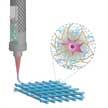
Recent developments in hydrogel chemistries, reinforcement approaches, and crosslinking methods have expanded the applications of 3D bioprinting to pharmaceutics, regenerative medicine, and biomedical devices. A multitude of 3D bioprinting techniques have been developed, but among these different approaches, extrusion-based 3D bioprinting has become a popular technique as it is easy to optimize and all its constituents are economical in price. A recent review elucidates the nuances of 3D bioprinting in a step-by-step guideline format, from its basics to more advanced levels.
